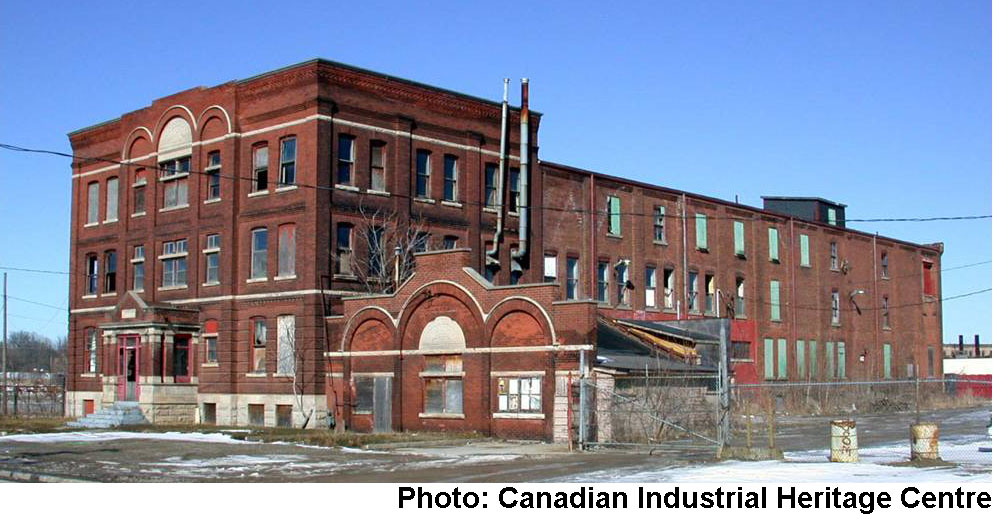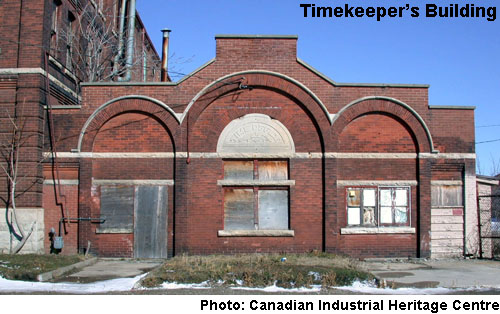
Cockshutt Office and Timekeeper's Building
 Cockshutt Office and Timekeeper’s Building, 66 Mohawk St., Brantford, Ontario – TIME IS RUNNING OUT ON DESIGNATED BUILDINGS
Cockshutt Office and Timekeeper’s Building, 66 Mohawk St., Brantford, Ontario – TIME IS RUNNING OUT ON DESIGNATED BUILDINGS
One of the last physical reminders of Brantford’s great industrial past may get swept away in the clean-up of a 52-acre brownfield site if a deal between the City and developer can’t be reached.
Why it matters
These two historic buildings are part of a once thriving 52-acre site that was originally home to several significant industries including the Cockshutt Plow Company, Verity Plow Company (an affiliate of Massey-Ferguson), the Adams Wagon Company, Brantford Coach and Body (affiliates of Cockshutt), and Sternson Chemicals. It was the industrial hub of Brantford.
Built in 1903 by the Cockshutt Plow Company, the Office and Timekeeper’s buildings are representative of Brantford’s late 19th century industrial architecture. Founded as the Brantford Plow Works by James G. Cockshutt in 1877, the company evolved into the most complete plow and tractor manufacturer in North America. The Cockshutt family made a valuable contribution to the farm implement industry around the world, and helped to shape the development of Branford through most of the 20th century.
The Office building displays a high degree of craftsmanship in its ornamental brickwork. In particular, a distinctive semi-circular pattern of bricks below the roofline that contains a stone inscription of the company name. A red brick façade was added to the Timekeeper’s building in 1912 to match the Office building. For the most part, their original brick exteriors have stayed intact.
Both the timekeeper's building and the larger adjoining former Cockshutt office building were designated under the Ontario Heritage Act in 2002.
 Why it’s endangered
Why it’s endangered
The buildings have been empty and abandoned for several years. There is interior water damage from several openings in the roof. A three-storey addition at the rear of the Office building, formerly used as a warehouse, has been partially demolished.
The City of Brantford has owned the buildings since 2005. It attempted to de-designate and demolish them in 2007 and has since done little if anything to protect them. In the fall of 2010, there was a small fire set by arsonists in a shed adjoining the building. There have been several cases of arson in other factory buildings on the larger site.
The City has been in negotiations with a developer to remediate and redevelop the site with various types of housing, and with the intention of adaptively reusing the Cockshutt buildings. After 19 months of negotiations, no deal had been reached.
It was recommended in 2009 that the City mothball the buildings and build a temporary roof to seal the opening, but nothing was done.
Where things stand
A resolution was reached in late June of 2011 directing City staff to take the first steps in cleaning up the brownfield. The resolution received unanimous approval. It directs staff to draw up a request for proposals for structural repairs to the Cockshutt Office and Timekeepers building, as well as three others nearby; the demolition of most other buildings on the site; soil remediation; and the acquisition of a record of site condition allowing the cleaned-up land to be used for residential and parkland development.
Many members of City council are hopeful the buildings will be preserved and the site will be cleaned up, but the longer they remain vacant, the more vulnerable they are to vandalism and arson. The resolution is a step in the right direction towards preserving this historically significant site, but the end result may be several years away.
The Canadian Industrial Heritage Centre hopes to one day re-use the buildings as a heritage centre to preserve and celebrate Canada’s industrial history.
Tragically, a suspicious fire resulted Council's decision to demolish the badly damaged Cockshutt Office. However, a decision was made to commit $37,000 to preserve the building if only to buy enough time to decide its long-term future.
UPDATE: In April 2012, councilors voted to demolish the buildings while retaining heritage elements as well as the façade of the Timekeeper’s Building. The buildings were torn down shortly thereafter.
Top 10 Endangered Places
- Explore Past Listings
- National
- British Columbia
- Alberta
- Saskatchewan
- Manitoba
- Ontario
- Our Lady of Assumption Church
- 24 and 28 King Street East, Gore Park
- 24 and 28 King Street East, Gore Park
- Abell
- Alma
- Amherst Island, north-eastern shore of Lake Ontario
- Bala Falls
- Bata
- Davisville Junior Public School/ Spectrum Alternative Senior School
- Districts
- Former Grand Trunk Railways Locomotive Repair Shops
- Gibson Isolation Hospital
- Hamilton Education
- Joachim
- Kingston Collegiate Vocational Institute (KCVI)
- Lister
- Nor’Wester Mountain Range and Loch Lomond Watershed Reserve
- Nottawasaga Lighthouse
- Ontario - Views
- Ontario Place
- Ottawa - Lansdowne Park
- POW Camp 30/Boys Training School National Historic Site
- Petrie Building
- Port Dalhousie
- Somerset House
- The Black Horse Pub and Pig’s Ear Tavern
- Tivoli Theatre
- Views of Legislative Assembly of Ontario Building
- Ontario - Porter/McKinley Block
- Brighton Public School
- Cockshutt
- The Barber Paper Mill
- Bellevue House
- Central Experimental Farm
- Guild Inn
- David Dunlap Observatory and Park
- Riverdale Hospital
- The Old Grand Trunk Railway Station
- Quebec
- New Brunswick
- Nova Scotia
- Prince Edward Island
- Newfoundland and Labrador
- Territories
- Worst Losses Archive
- Nominate a Site
